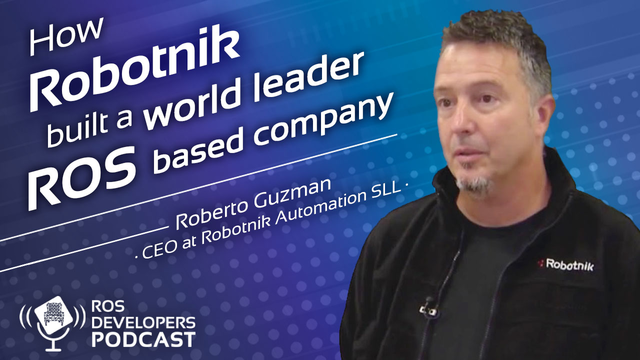
99. 2021 ROS Recap
Hello ROS Developers! The 2021 is about to finish. Another year in pandemic mode! I thought that the last week of the year would be a good moment to review how has it been the year for our favorite robotics framework. In this video we are going to evaluate the year for ROS in terms of hits. How much progress has made ROS along the year? Is ROS in a better position now than at the beginning of the year? Let’s have a look!Chronology
FEBRUARY
- We started the year in February, when NASA announced that ROS2 will be used in the Viper mission to the Moon and Open Robotics posted a job position to work in that project together with NASA. What an awesome start of the year! Later at the ROSWorld you can find a presentation delivered by one representative of NASA about this Viper mission.
MARCH
- But then, In March, Blue Origin posted another job announcement on the ROS Discourse forum looking for engineers with ROS2 knowledge for the development of Space ROS. Space ROS?!?! What is that?!?! We had no idea that that was on the table! Later in July, they will establish a collaboration with NASA to create this system together.
APRIL
- In April, I interviewed Sarah Gibson about their release of Unity for ROS. Unity launched the Unity-ROS set of packages to make work ROS with Unity simulations. The packages include ROS TCP endpoint, ROS TCP Connector and a Perception SDK aimed for the generation of training data for visual robotic systems. Packages for ROS2 were released a couple of months later.
MAY
- In May, Universal Robots in collaboration with Picknik, launched their ROS2 drivers for their UR robotic arms. That is a big step towards ROS2 usage because, as far as I know, the UR robots are the only industrial robots that you can buy right now with support for ROS2. Awesome!
JUNE
- Then, Husarnet announces that it goes Open source during the ROS Developers Day conference in June. Husarnet is a peer-to-peer secure VPN network for robots over the internet, which specially works well with ROS. Check out their presentation at the ROSDevDay conference.
JULY
- In July, Fetch was sold to Zebra Technologies for 290M$. Fetch is one of the flagships of the ROS community. Fetch Robotics was started by ROS pioneer Melonee Wise in 2014 and it was leading the market of ROS AMRs for warehouses. Being sold for such amount indicates the good health of AMRs based on ROS.
- At the same time, Softbank Europe laid off 40% of its workforce. It is worth to notice that Softbank robots do not run with ROS… I’m just saying…
AUGUST
- In August, Tesla announced that they will create a humanoid robot called the Tesla Bot. Even if I tried to get in contact with Elon Muck, I was not able to get an interview so what I’m explaining here are just my guesses. I think that their robot is not going to be based on ROS. Instead they will try to use their already in place operating system for their cars, in an attempt to create their own ecosystem, like Apple, using the same O.S for all the devices, cars, phones, robots, etc…
- Another interesting news for the ROS world made in August was the announcement of Intel to discontinue the development and selling of the RealSense. That is one of the main sensors used by the robotics community to perceive the world. A pity and a problem for roboticists which relied on that sensor for their robots. If that is your case, you can find a discussion about alternatives to the RealSense in ROS Discourse.
SEPTEMBER
- The final event of the DARPA Subterranean challenge was held in September and Team Cerberus won the 2millions of the systems competition. Team Dynamo the one man team of my friend Hilario Tome, won the 750$ of the virtual competition. Both teams used ROS1 to control their robots. Also, the whole virtual competition was running on Ignition, the robot simulator developed by Open Robotics.
OCTOBER
- In October, the Indy Autonomous Challenge was done. The competition is about controlling autonomous cars racing at more than 300km/h using ROS2 and Autoware software. There is a very interesting talk at the ROSWorld of this year about it.
- Also in October, the 3 community representatives for the ROS2 Technical Steering committee were elected: my friend Oliver Michel creator of the Webots robot simulator (who I interviewed about his Webots simulator), Brett Aldrich )who I interviewed for the podcast about his SMACC libraries for creating state machines in ROS with C++. He also delivered a presentation about SMACC for ROS2 at the ROSWorld this year. And , Patrick Musau, who I’ll be interviewing on the second week of January.
DECEMBER
- On December, Apex.AI, the company behind the first certified ROS2 based operating system for autonomous cars, announces that they have raised 56M$. Along the year, Apex has released the version 1.3 of their Apex.OS
ROS RELEASES
Along the year, the following releases of ROS were made:- First, Kinetic reached end of life in April this year
- ROS2 Galactic was launched on May
- Ignition Edifice was launched on March
- micro-ROS released v3.0.5 of the RCLC which fully includes ROS2 actions
CONFERENCES
- We started the year with the promise of finally having a ROS Con at New Orleans. Unfortunately, that was not possible and due to the pandemic, the conference was translated again online, converted in the second edition of ROS World. That, was successfully conducted in October.
- We also had ROSCon France which also was hold online, and ROS con japan,which was hold on-site, even is some speakers had to deliver their speech online because the could not enter the country
- Apart from the official conferences, this year we also had the MoveIt Day on March and the ROS Developers Day in June.
CONCLUSIONS
Based on this list of news about ROS, I consider 2021 a successful year for ROS. All the indicators are up, showing that ROS has a big future. And even more, I would declare 2021 the year of ROS2. In this year, is when we have seen ROS2 being applied to professional projects, to edge research challenges, to start to be taught at Universities and even been accepted by space agencies. That is why I declare 2021 the year of the switch to ROS2. It feels to me that the ROS community finally sees ROS2 mature enough for their projects. From that point ROS2 is going to get the relevance it deserves in the ROS world. So it is time that you switch if you have not done it yet! In case you haven’t done that change yet… you are late! If you don’t want to loose the trend and want to train your team to switch to ROS2, consider taking our 3 days intensive online workshop for teams, that will teach your team about everything they need to switch to ROS2 in three days. We use cloud simulations and remote connection to our real robots. It is 100% practice based. I hope I’ve not missed some other important news for the ROS world happening during the 2021 year. In case you think I did, please put them in the comments with links to the news. See you next year. And remember, that the robots of the future depend on you!Resources
- VIPER uses ROS: https://www.technologyreview.com/2021/04/12/1022420/nasa-lunar-rover-viper-open-source-software/
- Open Robotics position for developing at the Viper project: link not available anymore
- Space ROS presentation at ROS World 2021: https://vimeo.com/649649866/37198994b5
- Blue Origin job post to develop Space ROS: https://discourse.ros.org/t/space-robotics-engineers-blue-origin-advanced-development-programs-kent-wa/19472
- Draft document of collaboration between NASA and Blue Origin for the development of Space ROS: https://www.nasa.gov/saa/domestic/33802_20-20ACOFinal-0032-Blue_Origin_LLC_SAAwAttachments.pdf
- Interview to Sarah Gibson about Unity with ROS: https://www.theconstruct.ai/93-using-unity-with-ros-with-sarah-gibson/
- Unity with ROS video: https://youtu.be/6Vj23flmKLs
- Universal Robots ROS2 driver: https://github.com/UniversalRobots/Universal_Robots_ROS2_Driver
- Husarnet: https://husarnet.com/
- Controlling Remote Robots with Low Latency: https://youtu.be/_u1Citvgy3U
- Fetch Robotics original video:
- Teslabot video presentation:https://youtu.be/HUP6Z5voiS8
- Realsense alternatives discussion at ROS Discourse: https://discourse.ros.org/t/intel-cancelling-its-realsense-business-alternatives/21881
- DARPA Subterranean Challenge video by DARPAtv: https://youtu.be/BTwBne2kxNg
- INDY autonomous Challenge video by Willow Grove Weather Center: https://youtu.be/-6x3fclMPd8
- INDY autonomous challenge talk at ROS World: https://vimeo.com/649649590/efa6f41484
- ROS Discourse thread about the election of the ROS2 TSC community representative: https://discourse.ros.org/t/ros-2-technical-steering-committee-community-representative-election/22406
- ROS Developers Podcast interview to Olivier Michel about Webots robot simulator: https://www.theconstruct.ai/webots-robot-simulator-ros-olivier-michel/
- ROS Developers Podcast interview to Brett Aldrich about C++ SMACC: https://www.theconstruct.ai/the-new-generation-of-state-machines-for-ros-with-brett-aldrich/
- Apollo autonomous driving video: https://youtu.be/D1Ib1uCM7C4
- ROS World 2021: https://roscon.ros.org/world/2021/
- ROSCon Jp 2021: https://roscon.ros.org/jp/2021/
- ROSCon Fr 2021: https://roscon.fr/
- 4th ROS Developers Day: http://rosdevday.com/
Subscribe to the podcast using any of the following methods
- ROS Developers Podcast on iTunes
- ROS Developers Podcast on Stitcher
- ROS Developers Podcast on Spotify
Or watch the video
Podcast: Play in new window | Download | Embed
SUBSCRIBE NOW: RSS








